 Back
Back  Next
Next- The number of households with the elderly aged 65 or older was 16.85 million in 2002, accounting for 36.6% of the total households (46.01million). The breakdown shows that 3.41 million are for single-member households (20.2%), exceeding 20% for the first time, 4.82 million are for husband-and-wife households (28.6%), 2.63 million are for parents-and-unmarried child(ren) households (15.6%), and 4 million are for three-generation households (23.7%). This indicates that the percentage of three-generation households has decreased, while that of single-member households and that of parents-and-unmarried child(ren) households have increased. (Chart 1-2-1)
Chart 1-2-1. Trends in the Number of Households with Persons Aged 65 or Older and Percentage Distribution Thereof by Family Composition
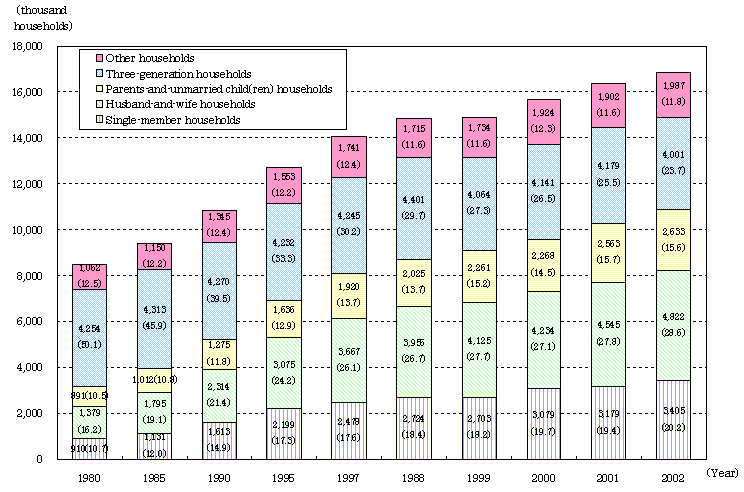
| Source: | Up to 1985: Ministry of Health and Welfare, "Basic Survey of Health and Welfare Administration" After 1986: Ministry of Health, Labour and Welfare, "Comprehensive Survey of Living Conditions of People on Health and Welfare" |
| Note: | 1. Hyogo Prefecture is excluded from figures in 1995. 2. Figures in parentheses refer to the rate to total number of households with persons aged 65 or older. |
- The percentage of the elderly living alone to the total elderly population aged 65 or older was 4.3% for males and 11.2% for females in 1980, while it strikingly increased in 2000, with males up to 8.0% and females up to 17.9%. It is estimated that the percentage of elderly living alone, above all males, will rise tremendously. (Chart 1-2-3)
Chart 1-2-3. Trends of the Elderly Living Alone
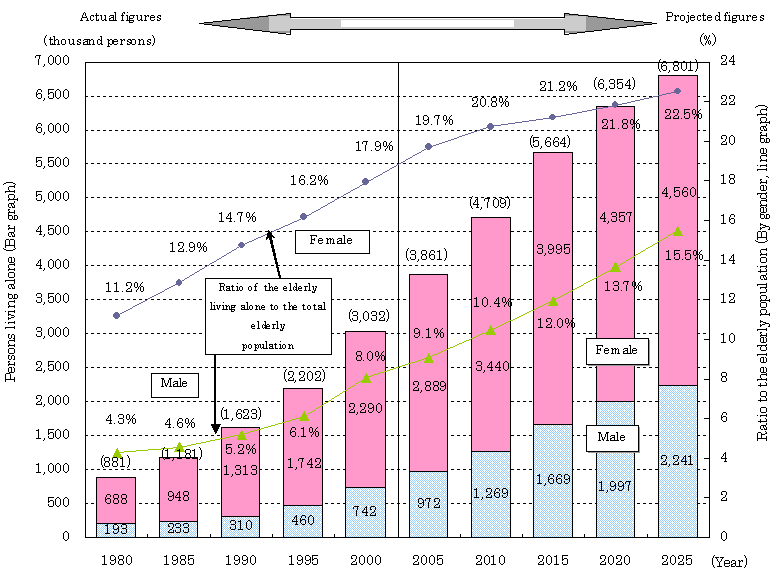
| Source: | Up to 2000: Ministry of Internal Affairs and Communications, "Population Census of Japan" After 2005: National Institute of Population and Social Security Research, "Household Projections for Japan," October 2003, "Population Projections for Japan," January 2002 |
| Note: | Figures in parentheses just above the bar graph refer to the total number of the male and female elderly living alone. |
- Regarding the elderly's livelihood, in elderly households (those composed of elderly 65+ only and elderly 65+ and their unmarried child(ren) under 18), the ratio of those who consider their present financial level to be "average" is higher than that of the total households, while the ratio for "tight" including both "very tight" and "somewhat tight" is low. (Chart 1-2-11)
Chart 1-2-11. Awareness about Living Conditions in Elderly Households

| Source: | Ministry of Health, Labour and Welfare, "Comprehensive Survey of Living Conditions of People on Health and Welfare," 2002 |
| Note: | "Elderly households" refers to the households comprising only person(s) aged 65+, and those comprising person(s) aged 65+ and unmarried person(s) under 18. |
- The average annual income of elderly households in 2001 was 3.046 million yen, merely half of the average of the total households (6.02 million yen). Concerning the amount per family member, since the average number of family members is less in elderly households, it becomes 1.953 million yen, with no large gap between the average amount of the total households (2.135 million yen) and the elderly households. (Table 1-2-13)
- The average personal income of males aged 65 or older is 3.036 million yen, while that of females is 1.124 million yen, which shows the average female income is just a little over one-third of the male income. The ratio of the female elderly 65+ with no income (16.5%) is much higher than that of males (4.4%). (Chart 1-2-15)
Table 1-2-13. Incomes of Elderly Households
| Average annual income (2001) | ||||
|---|---|---|---|---|
| Per household | Per household member (Average number of household members) |
|||
| Elderly households | Total income | 3,046 | 1,953 (1.56 persons) | |
| Earned income | 582 | (19.1%) | ||
| Public and retirement pensions | 2,126 | (69.8%) | ||
| House and land rent | 165 | (5.4%) | ||
| Interest and dividends | 15 | (0.5%) | ||
| Social security benefits other than pensions | 52 | (1.7%) | ||
| Remittance and others | 105 | (3.5%) | ||
| Total households | Total income | 6,020 | 2,135 (2.82 persons) | |
Chart 1-2-15. Elderly Income Standard by Income Category, 2000
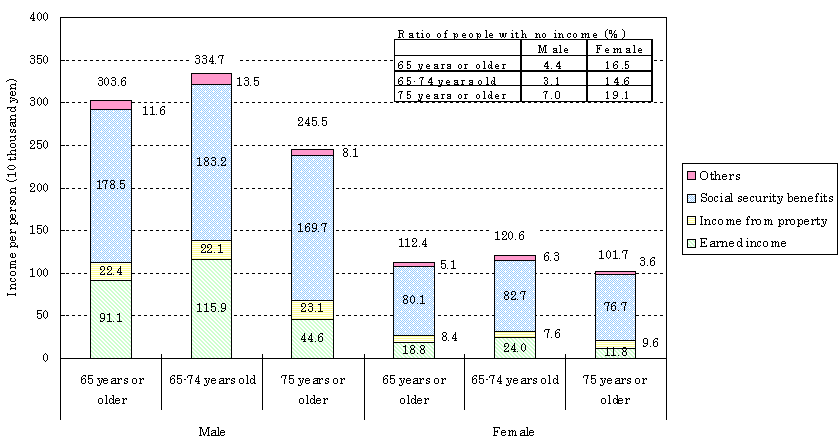
| Source: | Based on the re-totaled results of "Comprehensive Survey of Living Conditions of People on Health and Welfare" in "A Study on the Measures to Realize an Active and Productive Aging Society," 2002 |
| Note: | The mean value including people with no income. "Earned income" refers to the total amount of employees' income, business income, farming & livestock income and household labour income, that is, incomes by working. "Income from property" refers to the total of house/land rent and interest or a dividend. "Social security benefits" refers to the total of social security benefits including public and retirement pensions, and "others" refer to the total of incomes other than the above. |
- Observing saving conditions of households with householders aged 65 or older, their average savings in 2002 amounted to 24.2 million yen, about 1.4 times higher than those of total households (16.88 million yen). The number of households with savings of 40 million yen or more accounts for 18.6% of total households with householders aged 65 or older. (Chart 1-2-20)
Chart 1-2-20. Percentage Distribution of Savings in Households with Householders Aged 65 or Older
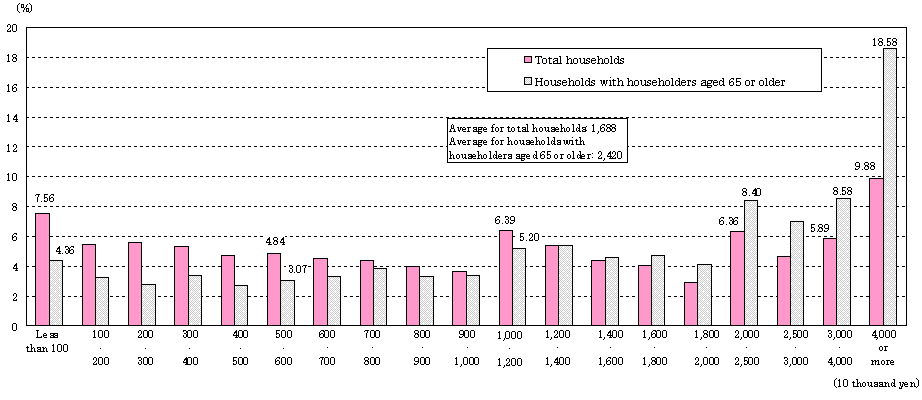
| Source: | Ministry of Internal Affairs and Communications, "Family Income and Expenditure Survey," 2002 |
| Note: | 1. Single-member households are excluded. 2. The above savings consist of deposits and savings to post offices, banks, and other financial institutions, bills for life insurance or reserve-type liability insurance, deposits to financial institutions such as shares, bonds, investment trust, and cash trust, intra-company deposits and deposits to non-financial institutions, including mutual aid associations related to one's work place. |
- The ratio of working males aged 55-59 is 89.9%, 66.5% among men aged 60-64, and 51.6% among men aged 65-69. Among workless males aged 60-64 (33.5%), more than 50% hope to work, and so do nearly 40% of those aged 65-69 (48.4%).
- The ratio of working females aged 60-64 is 41.5%, and 28.7% among women aged 65-69. Over 30% of workless women aged 60-64 (58.5%) and over 20% of those aged 65-69 (71.3%) wish to work. (Chart 1-2-25)
Chart 1-2-25. Working and Workless Status of the Elderly
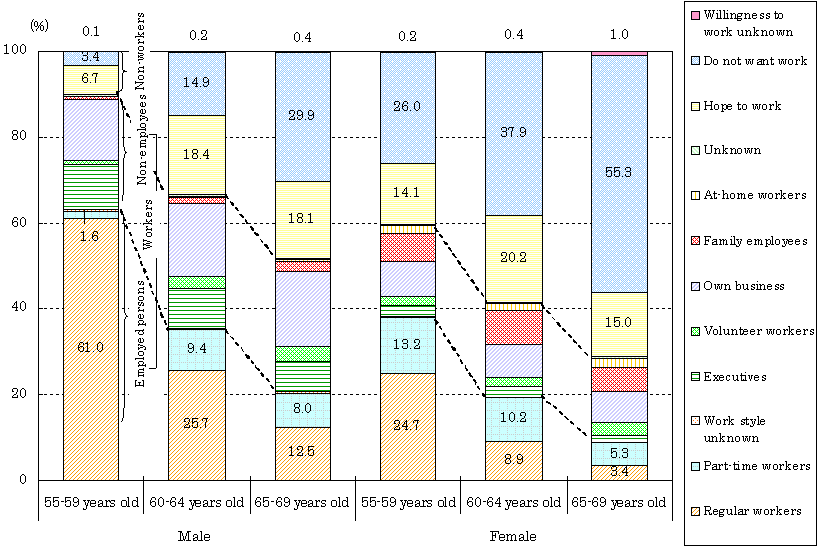
| Source: | Based on Ministry of Health, Labour and Welfare, "Survey of Working Condition on Advanced Aged Workers," 2000 |
- Regarding health conditions of the elderly, the ratio of the elderly aged 65 or older (except for those hospitalized) with some subjective symptom due to illness or injury was 502.7 per 1000 in 2001. The ratio of the elderly aged 65 or older with a negative impact on their daily life (those having trouble with transportation, outings, work, house chores, study, exercise, sports, etc. because of health problems, except for those hospitalized) is 235.0 per 1000 in the elderly population. (Chart 1-2-28)
Chart 1-2-28. Ratios of Elderly 65+ with Complaints and with a Negative Impact on Their Daily Lives
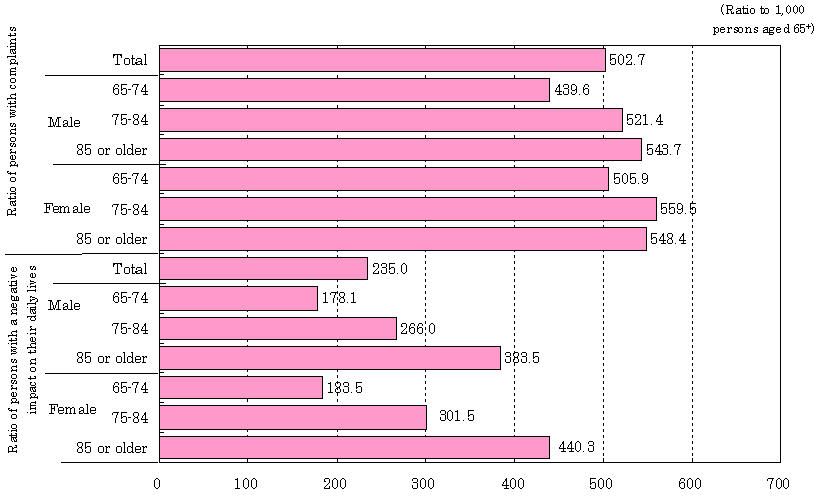
| Source: | Ministry of Health, Labour and Welfare, "Comprehensive Survey of Living Conditions of People on Health and Welfare," 2001 |
- Among the issues they are paying attention to for maintaining health, the biggest is "sufficient rest and sleep" (60.4%), followed by "keep regular hours" (53.0%) and "nutritious and balanced meals" (49.5%). (Chart 1-2-31)
Chart 1-2-31. Issues Kept in Mind for Health Improvement
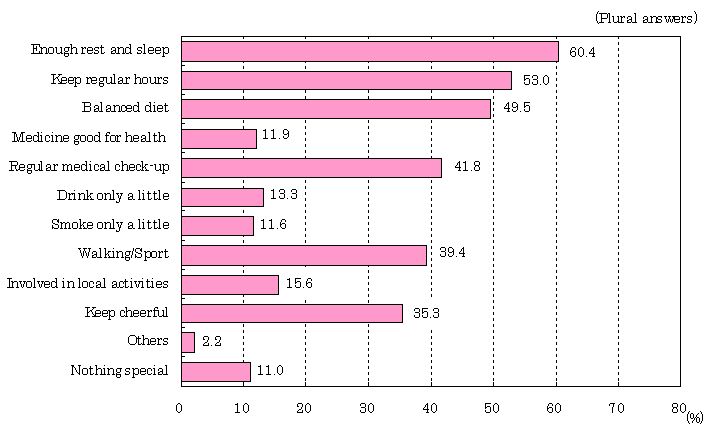
| Source: | Cabinet Office, "The Survey on Health Consciousness of Senior Citizens," 2002 |
| Note: | Results of the national survey for men and women aged 65 or older |
- The number of persons aged 65 or older certified as requiring care or assistance was 3.324 million at the end of FY2002. (Table 1-2-36) According to the review in April 2003, the number of insured persons aged 65 or older who received Long-term Care Insurance services was 2.69 million. (Table 1-2-37)
Table 1-2-36. Status of the Elderly Requiring Care (Number of certified persons requiring long-term care or support)
| Total number of persons certified as requiring long-term care or support |
Support required |
Care level 1 | Care level 2 | Care level 3 | Care level 4 | Care level 5 | |
|---|---|---|---|---|---|---|---|
| Total insured persons | 3,445,186 (100.0) |
498,992 (14.5) |
1,056,269 (30.7) |
635,834 (18.5) |
425,712 (12.4) |
419,292 (12.2) |
409,087 (11.9) |
| Number of category 1 insured persons (65 years or older) | 3,324,156 (100.0) |
492,979 (14.8) |
1,022,487 (30.8) |
604,853 (18.2) |
408,350 (12.3) |
405,036 (12.2) |
390,451 (11.7) |
| 65-74 years old | 600,225 (100.0) |
95,856 (16.0) |
187,691 (31.3) |
116,200 (19.4) |
70,328 (11.7) |
63,362 (10.6) |
66,788 (11.1) |
| 75 years or older | 2,723,931 (100.0) |
397,123 (14.6) |
834,796 (30.6) |
488,653 (17.9) |
338,022 (12.4) |
341,674 (12.5) |
323,663 (11.9) |
| Source: | Ministry of Health, Labour and Welfare, "Annual Report on the Status of the Long-term Care Insurance Project," 2002 |
| Note: | 1. As of the end of March 2002. 2. Figures in parentheses are the ratio to the total number of certified persons requiring long-term care or support (Unit: %). |
Table 1-2-37. Status of Utilization of Long-term Care Insurance Services
(Number of persons who received Long-term Care Insurance services)
| Total | Support required | Care level 1 | Care level 2 | Care level 3 | Care level 4 | Care level 5 | |
|---|---|---|---|---|---|---|---|
| Total number of recipients (65 years or older) |
2,690.5 (100.0) |
321.8 (12.0) |
794.0 (29.5) |
509.6 (18.9) |
361.4 (13.4) |
363.9 (13.5) |
339.8 (12.6) |
| Male | 746.8 (100.0) |
69.9 (9.4) |
197.8 (26.5) |
165.1 (22.1) |
116.5 (15.6) |
107.3 (14.4) |
90.6 (12.1) |
| Female | 1,943.6 (100.0) |
252.1 (13.0) |
596.2 (30.7) |
344.6 (17.7) |
245.1 (12.6) |
256.4 (13.2) |
249.3 (12.8) |
| Source: | Ministry of Health, Labour and Welfare, "Monthly Report on the Actual Condition Survey Concerning Long-term Care Benefits," April 2003 |
| Note: | Figures in parentheses are the ratio to the total number of recipients (Unit: %) |
- As to exchanges with the neighbors, the female percentage for "enjoying friendly communication" is higher than the male's. (Chart 1-2-48)
Chart 1-2-48. Exchanges with Neighbors
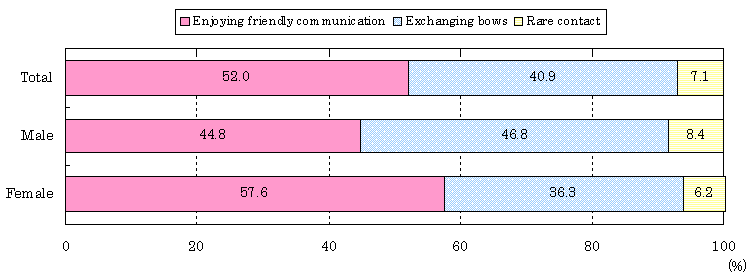
| Source: | Cabinet Office, "Attitude Survey on Participation in Local Communities by the Elderly,'' 2003 |
| Note: | Results from a survey for men and women aged 60 or older nationwide. |
- As for elderly housing, 70.8% of single-member households and 76.6% of husband-and-wife households have satisfied the Leading Housing Standard (a guideline to lead enhancing housing stock quality in the Eighth House-building Five-year Plan). In the households occupying rental houses, merely 41.1% of single-member households and 34.0% of husband-and-wife households are above the standard level.
- Regarding how often the elderly go out, "almost everyday" is the highest (48.2%), followed by "2 or 3 days a week" (22.3%), and "4 or 5 days a week" (15.7%). The ratio of "almost every day" is high among males, while that of "less than once a week" is high among females. By age group, the older the age group is, the lower "almost every day" is, and instead "less than once a week" is higher. (Chart 1-2-61)
- The number of the elderly aged 65 or older who died in traffic accidents in 2003 came to 3,109, accounting for 40.4% of the total deaths by traffic accidents. Although the young aged 16 to 24 had made up the majority of deaths due to traffic accidents until 1992, the elderly exceeded the young in 1993. Since then, the ratio of the elderly has continued to increase, while that of the young has continued to decrease. (Chart 1-2-65)
Chart 1-2-61. How frequently do the elderly go out?
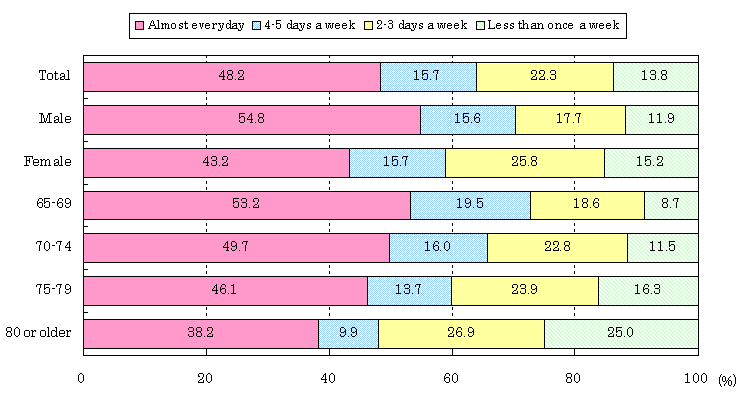
| Source: | Cabinet Office, based on "Attitude Survey on Participation in Local Communities by the Elderly," 2003 |
Chart 1-2-65. Trends in Traffic Accident Deaths by Age Group
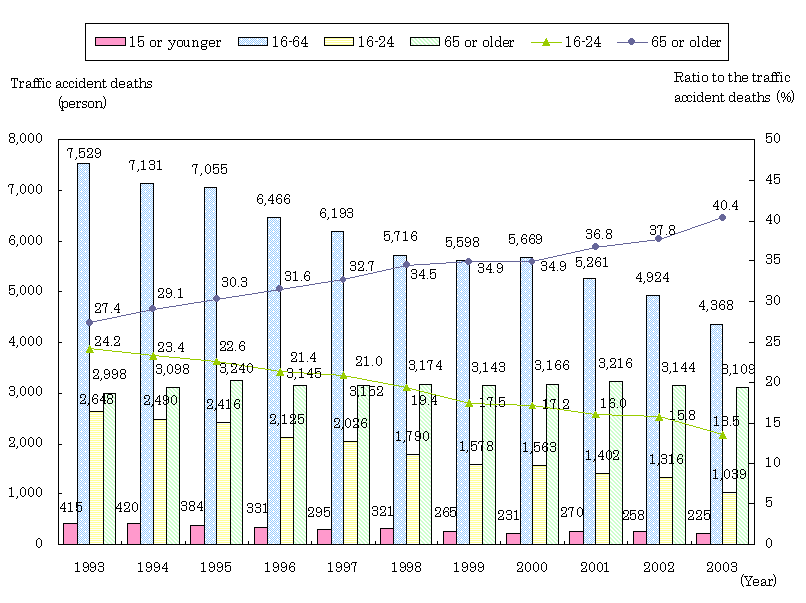
| Source: | National Police Agency, "Traffic Statistics" |
Top Page > Annual Report on the Aging Society > Annual Report:2004